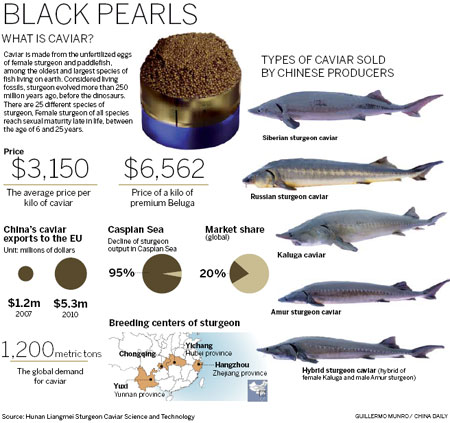A sector based on good taste
Updated: 2012-04-12 07:47
By Wu Wencong (China Daily)
|
||||||||
At Thousand Island Lake, for example, the highest water temperature in summer is 33 C, far too high for at least two species raised there, the Siberian and Amur sturgeon, which require a temperature of 22 C.
The surface area of the lake is 573 million square meters, and so the fish are held in underwater cages - covering around 40,000 sq m - to ensure that they can be captured easily. Each year, as summer approaches and temperatures soar, workers at the center transfer the sturgeon from the submarine cages to a "summer resort" pool, excavated on an island in the lake. Cooler water, taken from a depth of 15 meters and averaging around 16 C, is continuously pumped into the pool.
The sturgeon usually spend around three months in the resort. "We start transferring the fish in early June so they will survive the hottest period between July and September," said Gong Liang, deputy director of the center. He said the transference of the fish is the most labor-intensive part of his job, standing in water under a sweltering sun several hours a day for a month, netting sturgeon that can easily weigh more than 100 kilograms. "It's really strenuous labor," said Gong, "But the good news is that we take a monthlong vacation once it's completed."
In 1997, researchers at the Chinese Academy of Fishery Sciences began to import tens of millions of fertilized eggs from Siberia. The same year saw the start of a program to breed wild sturgeon in the Heilongjiang River in northeast China. "The breeding project there was aimed at preserving the species," said Wang Bin, a former researcher at the academy, who was in charge of developing the method of cultivation and promoting it throughout the country.
Wang said rivers are the best places for wild sturgeon, which require a course as long as 1,000 kilometers to spawn, with the foods available in the river and the stimulation provided by the current playing an important role in the spawning process. "But, it (Northeast China) is not an ideal place to farm sturgeon, because they are kept within a restricted area," he said. "Moreover, it takes around two or three years before a sturgeon grows to more than 1 kg. In the south, the time required is just one year."
In 1999, when the breeding process first began to spread in China, sturgeon cost more than 200 yuan ($32) per kg in the markets, and more than 1,000 yuan in upmarket eateries. The average house price in Beijing at that time was just around 3,000 yuan per sq m.
However, by 2003, when an increasing number of people began to enter the industry, the price dropped to about 40 yuan per kg.
Wang saw a second chance for the industry after he investigated overseas and realized that sturgeon eggs were far more valuable than the flesh. So he left the academy in 2003 and immersed himself in the industry. Now he is the general manager of Hangzhou Qiandao Xunlong Sci-Tech Co, one of the first Chinese companies to export caviar.


 Relief reaches isolated village
Relief reaches isolated village
 Rainfall poses new threats to quake-hit region
Rainfall poses new threats to quake-hit region
 Funerals begin for Boston bombing victims
Funerals begin for Boston bombing victims
 Quake takeaway from China's Air Force
Quake takeaway from China's Air Force
 Obama celebrates young inventors at science fair
Obama celebrates young inventors at science fair
 Earth Day marked around the world
Earth Day marked around the world
 Volunteer team helping students find sense of normalcy
Volunteer team helping students find sense of normalcy
 Ethnic groups quick to join rescue efforts
Ethnic groups quick to join rescue efforts
Most Viewed
Editor's Picks

|

|

|

|

|

|
Today's Top News
Health new priority for quake zone
Xi meets US top military officer
Japan's boats driven out of Diaoyu
China mulls online shopping legislation
Bird flu death toll rises to 22
Putin appoints new ambassador to China
Japanese ships blocked from Diaoyu Islands
Inspired by Guan, more Chinese pick up golf
US Weekly

|

|







